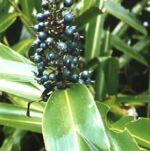| Common Name: |
Galangal |
| Other Names: |
Alpinia, Catarrh Root, Chinese Ginger, East India Root, India Root, Lesser Galangal |
| Botanical Name: |
Alpinia officinarum |
| Genus: |
Alpinia |
| Family: |
Zingiberaceae |
| Cultivation: |
Well-drained, rich soil in partial shade with high humidity. Spider mite may attack plants under cover. |
| Propagation: |
By division of rhizomes as new growth begins. |
| Harvest: |
Rhizomes four to six years old are lifted at the end of the growing season and used fresh, or dried for use in decoctions, liquid extracts, and tinctures, or distilled for oil. |
| Native Location: |
China and Vietnam |
| Height: |
75cm-1.2m (2½-4ft) |
| Width: |
Indefinite |
| Hardiness: |
Min. 15-18°C (59-64°F) |
| Parts Used: |
Rhizomes (gao liang), oil. |
| Properties: |
A bitter, aromatic, stimulant herb that acts mainly on the digestive system. It also relieves pain, lowers fever, and controls bacterial and fungal infections. |
| Medicinal Uses: |
Internally for digestive upsets, chronic gastritis and gastric ulceration, epigastric and rheumatic pain. Externally for skin infections, skin cancer, and gum disease. To treat pain, particularly stomach pain. Germany's Commission E has approved the use of lesser galangal to treat loss of appetite and dyspeptic complaints, such as heartburn and bloating. |
| Typical Dose: |
A typical dose of lesser galangal may range from 0.5 to 1.0 gm mixed with 150 ml boiling water, allowed to steep ten minutes, drained as taken as a tea. |
| Possible Side Effects: |
No side effects are known when lesser galangal is taken in designated therapeutic doses. |
| Drug Interactions: |
| Taking lesser galangal with these drugs may interfere with the action of the drug: |
| Aluminum Hydroxide, (AlternaGel, Alu-Cap) |
Aluminum Hydroxide and Magnesium Carbonate, (Gaviscon Extra Strength, Gaviscon Liquid) |
Aluminum Hydroxide and Magnesium Hydroxide, (Maalox, Rulox) |
Aluminum Hydroxide and Magnesium Trisilicate, (Gaviscon Tablet) |
| Aluminum Hydroxide, Magnesium Hydroxide, and Simethicone, (Maalox, Mylanta Liquid) |
Calcium Carbonate, (Rolaids Extra Strength, Tums) |
Calcium Carbonate and Magnesium Hydroxide, (Mylanta Gelcaps, Rolaids Extra Strength) |
Cimetidine, (Nu-Cimet, Tagamet) |
| Esomeprazole, (Nexium) |
Famotidine, (Apo-Famotidine, Pepcid) |
Famotidine, Calcium Carbonate, and Magnesium Hydroxide, (Pepcid Complete) |
Lansoprazole, (Prevacid) |
| Magaldrate and Simethicone, (Riopan Plus, Riopan Plus Double Strength) |
Magnesium Hydroxide, (Dulcolax Milk of Magnesia, Phillips' Milk of Magnesia) |
Magnesium Oxide, (Mag-Ox 400, Uro-Mag) |
Magnesium Sulfate, (Epsom Salts) |
| Nizatidine, (Axid, PMS-Nizatidine) |
Omeprazole, (Losec, Prilosec) |
Pantoprazole, (Pantoloc, Protonix) |
Rabeprazole, (Aciphex, Pariet) |
| Ranitidine, (Alti-Ranitidine, Zantac) |
Sodium Bicarbonate, (Brioschi, Neut) |
|
| Culinary Uses: |
Rhizome has a pungent peppery, ginger-like flavor, used to flavor vinegars and liqueurs. |
| Bibliography: |
Encyclopedia of Herbs by Deni Brown. Copyright © 1995, 2001 Dorling Kindersley Limited. pg 116
The Essential Herb-Drug-Vitamin Interaction Guide by Geo. T. Grossberg,MD and Barry Fox,PhD Copyright©2007 Barry Fox,PhD. pp.306-307
|

